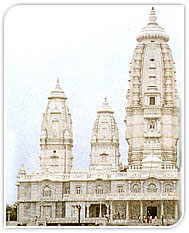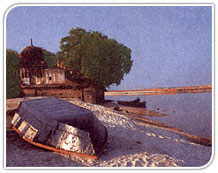 Home
>>States >> Uttar
Pradesh >> Kanpur Travel Guide
Home
>>States >> Uttar
Pradesh >> Kanpur Travel Guide
Kanpur Travel Guide
 Nestled
on the banks of the eternal Ganga, Kanpur stands as one of North India's
major industrial centers with its own historical, religious and
commercial importance. Believed to be founded by king Hindu Singh of the
erstwhile state of Sachendi, Kanpur was originally known as 'Kanhpur'.
Nestled
on the banks of the eternal Ganga, Kanpur stands as one of North India's
major industrial centers with its own historical, religious and
commercial importance. Believed to be founded by king Hindu Singh of the
erstwhile state of Sachendi, Kanpur was originally known as 'Kanhpur'.
History:
Historically, Jajmau on the eastern
outskirts of present day Kanpur is regarded as one of the most archaic
townships of Kanpur district. Upto the 1st half of the 18th century
Kanpur continued to survive as an insignificant village. Its fate,
however, took a new turn soon after. In May, 1765, Shuja-ud-daula the
Nawab Wazir of Awadh, was defeated by the British near Jajmau. It was
probably at his time that strategic importance of the site of Kanpur was
realized by the British.
European
businessmen had by this time gradually started establishing themselves
in Kanpur. In order to ensure protection to their lives & property
the 'Awadh local forces' were shifted here in 1778. Kanpur passed into
British hands under the treaty of 1801 with Nawab Saadat Ali Khan of
Awadh. This forms a turning point of the history of Kanpur. Soon Kanpur
became one of the most important military stations of British India. It
was declared a district on 24th March, 1803. Kanpur was soon to become
the epicentre of the outbreak of 1857, as some of the leading luminaries
of the War of Independence hailed from here, namely - Nana Sahib,
Tantiya Tope, Azimoolah Khan & Brigadier Jwala Prasad. The three
strategic events of the 1857 war at Kanpur were the fight at 'wheeler's
entrenchment', the 'massacre at Sati Chaura Ghat' and the 'Bibighar
massacre'. Nana Sahib had declared independence on the 7th of June, 1857
at Kanpur. The British under Commander Hugh Wheeler retreated into a
shallow earth entrenchment in the cantonment area, later known in
history as 'wheeler's entrenchment'. The English garrison surrendered in
the last week of June 1857 on terms of safe passage to Allahabad.
 But
when on the morning of 27th June, the soldiers along with the women &
children were about to embark into the boats at Sati Chaura Ghat,
fighting broke out and most of the men were killed. The survivors, women
& children were rescued who were imprisoned into the Savada Kotihi &
later shifted to Bibighar in the cantonment magistrates' compound. But
when it became clear that relieving force under General Havelock were
nearing the city and defeat was inevitable, the captives-all women &
children, were massacred and their dismembered bodies buried in the well
of the compound on 15th July, 1857. The Bibighar was dismantled by the
British on reoccupation of Kanpur and a 'memorial railing and a cross'
raised at the site of the well. The well is now bricked over. Only
remains of a circular ridge survive, which can be still seen at the Nana
Tao park.
But
when on the morning of 27th June, the soldiers along with the women &
children were about to embark into the boats at Sati Chaura Ghat,
fighting broke out and most of the men were killed. The survivors, women
& children were rescued who were imprisoned into the Savada Kotihi &
later shifted to Bibighar in the cantonment magistrates' compound. But
when it became clear that relieving force under General Havelock were
nearing the city and defeat was inevitable, the captives-all women &
children, were massacred and their dismembered bodies buried in the well
of the compound on 15th July, 1857. The Bibighar was dismantled by the
British on reoccupation of Kanpur and a 'memorial railing and a cross'
raised at the site of the well. The well is now bricked over. Only
remains of a circular ridge survive, which can be still seen at the Nana
Tao park.
The Kanpur Memorial Church
'The all
souls cathedral' was raised in honour of the fallen at the northeast
corner of wheeler's entrenchment in 1862 by the British. The marble
Gathic screen with famous 'mournful seraph' was transferred to the
churchyard of All Souls Church after independence in 1947, and in its
place a bust of Tantiya Tope installed and the Garden renamed as Nana
Rao Park'. After 1857, the development of Kanpur was even more
phenomenal. Government Harness and Saddlery Factory was started for
supplying leather material for the army in 1860, followed by Cooper
Allen & Co.in 1880. The first cotton textile mill, the Elgin Mills
were started in 1862 and Muir Mills in 1882.
Today besides
being the most industrialist region of the state, Kanpur is also an
important educational centre, with institutions like Harcourt Butler
Technological Institute, Agricultural College, National Sugar Institute
& Govt. Textile Institute being located here.
Apart from
playing a stellar role in the development of the country as a whole,
Kanpur has also been instrumental in making an unforgettable
contribution to the Indian freedom struggle. A favorite centre of
activities of stalwarts like Nanarao Peshwa, Tantiya Tope, Sardar Bhagat
Signh and Chandrashekhar Azad among others, Kanpur is also the birth
place of Shyamlal Gupta 'Parshad', composer of the famous patriotic
ditty 'Vijayee Great Hindi leterateurs like Acharya Mahavir Parasad
Dwivedi, Ganesh Shankar Vidyarthi, Pratap Narain Mishra, Acharya Gaya
Prasad Shukla 'Sanehi' and Balkrishna Sharma 'Navin' having hailed from
here.
Special
Offers on Hotels & Resort Booking in Kanpur
Travel
Agents & Tour Operators offering Travel Packages in Kanpur
Nestled on the banks of the eternal Ganga, Kanpur stands as one of North India's major industrial centers with its own historical, religious and commercial importance. Believed to be founded by king Hindu Singh of the erstwhile state of Sachendi, Kanpur was originally known as 'Kanhpur'.
But when on the morning of 27th June, the soldiers along with the women & children were about to embark into the boats at Sati Chaura Ghat, fighting broke out and most of the men were killed. The survivors, women & children were rescued who were imprisoned into the Savada Kotihi & later shifted to Bibighar in the cantonment magistrates' compound. But when it became clear that relieving force under General Havelock were nearing the city and defeat was inevitable, the captives-all women & children, were massacred and their dismembered bodies buried in the well of the compound on 15th July, 1857. The Bibighar was dismantled by the British on reoccupation of Kanpur and a 'memorial railing and a cross' raised at the site of the well. The well is now bricked over. Only remains of a circular ridge survive, which can be still seen at the Nana Tao park.